Educator as Lead Learner: Learning littleBits
I have discussed educators as model learners before:
The educator’s role has or should change in this age of information abundance or Education 2.0-3.0. The educator’s role has always been to model and demonstrate effective learning, but somewhere along the line, the major role of the educator became that of content and knowledge disseminator. Now that in this information age content is freely and abundantly available, it is more important than ever to assist learners in the process of how to learn. (Educator as Model Learner)
I advocate for the educator, as leader learner, to demonstrate the process of learning:
To effectively do so, though, the educator needs to understand and be able to articulate and demonstrate the process of learning, him or herself. It is a mistaken assumption that educators know how to do so. The learning process can be made overt through recording and clearly articulating the steps, procedures, and/or strategies for doing so. (Educators as Lead Learners)
To learn and model this process, I recommend that educators pick something new to learn and practice doing the following: 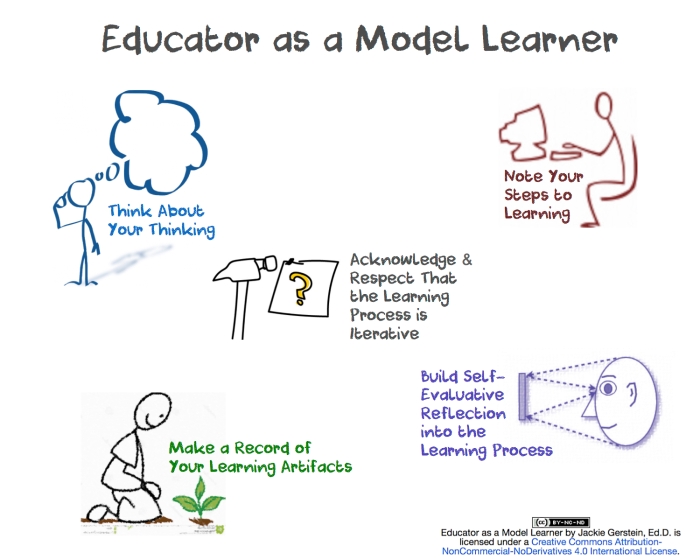 I am teaching at a maker education camp this summer and want to integrate LittleBits into my curriculum. As such, I am learning how they work. In order to model my process as lead learner, I noted how I am learning how to use Littlebits. I will ask the older kids to do a similar process and will have them explore my documentation to get an idea how to do this.
I am teaching at a maker education camp this summer and want to integrate LittleBits into my curriculum. As such, I am learning how they work. In order to model my process as lead learner, I noted how I am learning how to use Littlebits. I will ask the older kids to do a similar process and will have them explore my documentation to get an idea how to do this.
Note My Steps to the Learning Process
Why I Became Interested As a avid user of Twitter, I have a column for tweets hashtagged as #makered. LittleBits come up often. I have been watching how they evolved over the past year or so; and how they support and are being used by educators. Purchasing and Examining LittleBits LittleBits has several kits. I looked them over online and decided to purchase two kits: The Basic and the Arduino Coding Kit. I examined both sets to insure I was getting different LittleBits with the two kits. Since I am a consumer shopper, I found both these sets via eBay – new for about half of the original cost – score!
How I Am Learning
As many of us do in this century of learning, I go online to find tutorials. I am using the following resources to help me get acquainted
- http://littlebits.cc/tips-tricks/getting-to-know-the-base-premium-deluxe-kits
- https://www.youtube.com/watch?v=6USwUexyXBg#t=59
I try a few of the simple projects to learn about the functions of the different Littlebits. I then read over the projects offered in the manual. I mentally picture building them. Because I knew I could easily build the beginning ones, I skip to the last project in the manual – the Three-Wheeler and also view it online: https://www.youtube.com/watch?v=niEsF4jeXU0. I have a belief that maker education is not about copying what has been already created. As such, I think about how I wanted to adapt the projects.
I conceptualize an adaptation of the three-wheeler as a cat toy/feeder. I come up with a mental picture of the cat toy-feeder. I would be using the light light sensor and bar graph to activate the toy when the sun comes up in the morning. Once activated due to the sun, the engine would move and the LED in the feathered tail would light up. The moving device with the trailing feathers and LED would encourage my cat to chase it, hence getting a little exercise prior to catching the reward of her cat food situated on the truck bed. Her body would cover the light sensor causing it to stop and giving her a chance to eat (photos can be found at the end of this post).
I have a bunch of Legos and tinker toys that I use when teaching and bring these out to help me build. Combining the Legos with Littlebits makes sense but connecting them takes some work with the use of tape. I guess LittleBits figured this out because I went online and found the brick adapter: http://littlebits.cc/accessories/brick-adapter. Because I have so many parts which includes LittleBits, Legos, Tinker Toys – some on the top and some on the bottom, I have to manipulate and play with different configurations to get everything to fit together and work correctly.
Thinking About My Thinking
Some of the thoughts I had during the building of this project:
- I love that I can jump on the internet and immediate get tutorials and example projects that others have done.
- I like the car project and believe the kids will like this, too, but I want to create my own version rather than following the directions as written.
- I have all of these building supplies from teaching – Legos, Tinker Toys, Pico Cricket. I can go find those to use with the LittleBits in order to complete my own design.
- How silly it is that I am an older woman “playing” with Legos. I need to let go of this thought.
- I figured some things out but dropping the little pieces a lot frustrated me. I decided to put it away and start again tomorrow morning.
- I feel a sense of accomplishment figuring out how to “fix” things so they work better.
- I think that being a ceramics potter and teaching EdTech has made me a better problem solver.
- I used the LittleBits motor to make it move, how can I use some of the other LittleBits to embellish it – add more features?
- I like combining the Littlebits with Legos but they are a little unruly. I have to “MacGyver” them together. This is making the project a lot more difficult.
- I know that letting ideas float around in my mind for a while often yields results, so after thinking about how I might adapt it, I came up with a cat feeder and toy.
- I know that I can successfully visualize art projects without needing to sketch them out. I know this is not true for everyone.
- It is taking a lot more time than expected – hopefully my hard work will pay off.
- Not having the right tools (e.g., not have the brick connectors) can be very frustrating.
- I don’t like how all of the electrical tape is showing so I’ll cover the top of the Lego plate. It will also serve to create a surface that will more easily clean off the cat food.
- Yea – it works. I am laughing and clapping at the whimsical nature of this project.
Iterations
The maker movement is driven by the DIY movement, creating and recreating new “things.” At its core, then, making is about experimentation, about trial and error, about trying things out to see what works and what doesn’t. As such, failure is seen as iteration. Part of being a lead learner, of understanding and documenting the learning process is recording the iterations of the project. I engaged in a lot of experimentation but had basically two iterations. I believe I would have had more but due to some experience with robotics, I had a good idea of what would work – not work.
1st Iteration
- Had wheel extended too far back – couldn’t mount the motor.
- Front wheels bumping into base – needed to add spacers.
- The single back wheel didn’t work with a Lego wheel; too long of a motor stem made the wheel off centered and with the weight of the motor it fell to one side.
2nd Iteration
The second iteration was actually the final one but it took a lot of manipulating the back wheel and motor to get them to stay put.
Self-Evaluation
I worked on this project over two days. I feel successful in a number of ways:
- Because I have done some simple robotics (Pico Crickets), ith my students before, I found that this background, helped me understand the functions of many of the Littlebits. It felt good to be able to quickly understand how Littlebits functioned.
- I am proud of the final project in terms of function but not so much in form. I don’t like all the tape I used and the wheel is a bit precariously connected. Maybe I’ll buy to brick connectors at some point.
- I was very excited about the final project. It worked as I conceptualized and my cat enjoyed it, too!
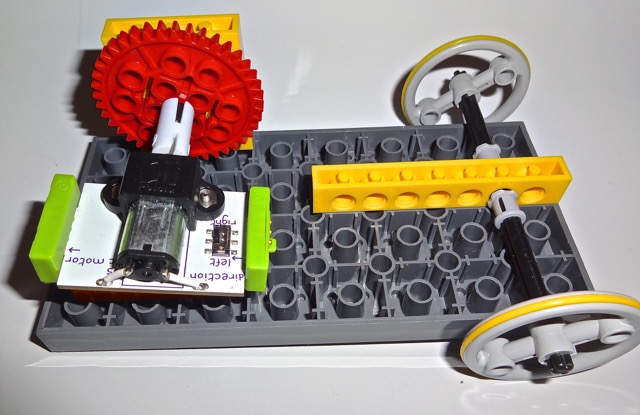
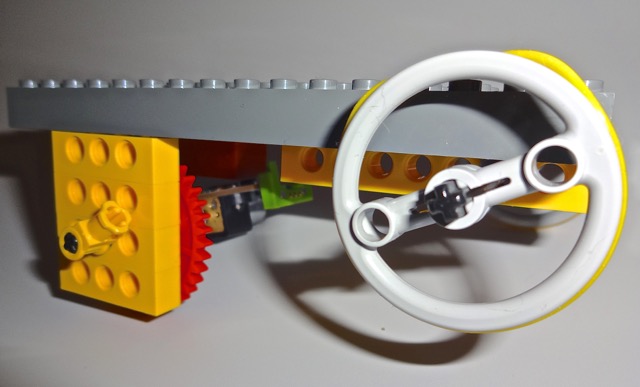
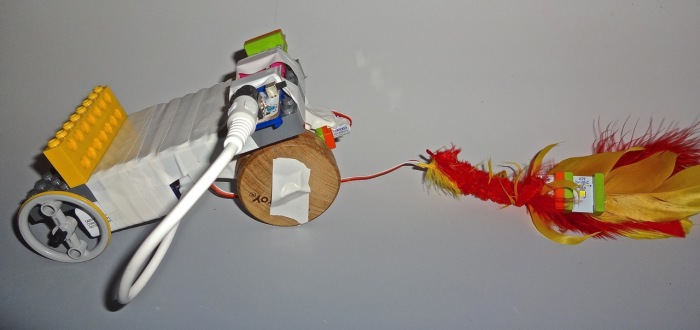
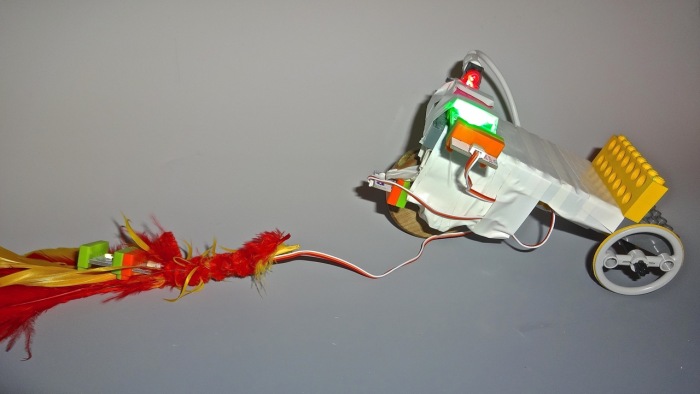
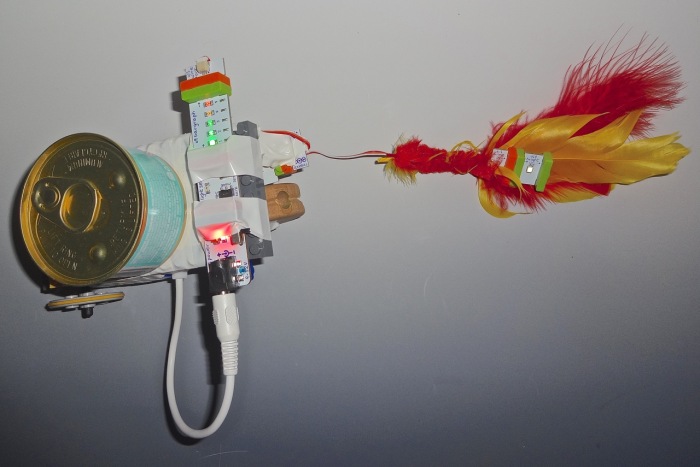
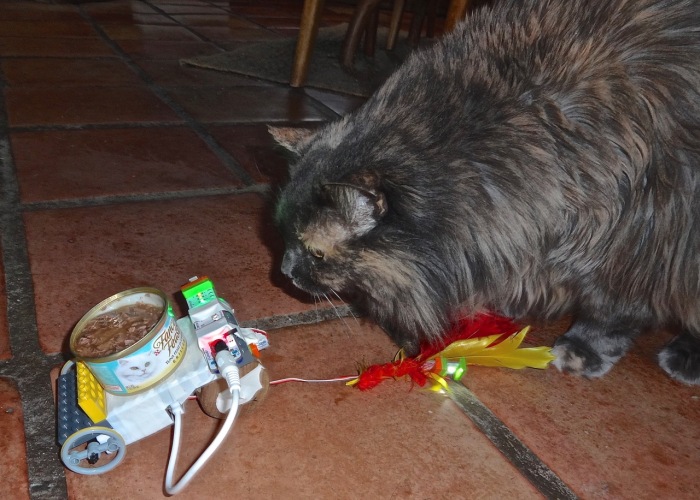
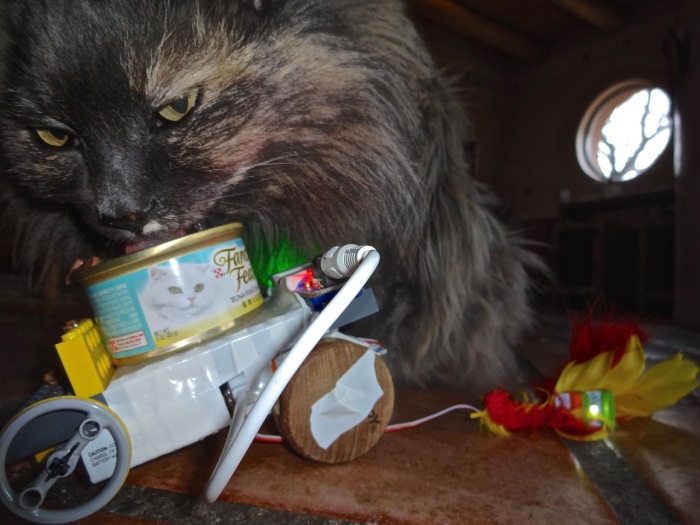

Another thought provoking post Jackie. The notion of teacher as learner is powerful and the truth that we don’t always have the capacity to describe how we learn is important. If you have not already come across it you might get something from, “The Art of the Maker” by Peter Dormer. In it he puts himself through he exercise of learning a new skill while consciously analysing the process.
geraintwilton
February 23, 2015 at 1:55 pm
Thanks Gerain! The book looks interesting but is $117 on Amazon 🙂
Jackie Gerstein, Ed.D.
February 23, 2015 at 2:50 pm
I love how you documented how you went through the design process while building your creation. Documentation of the process is a valuable skill for us to teach to our students.
dianalrendina
March 8, 2015 at 1:11 pm